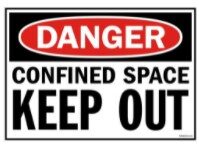Two employees of an Avondale, Arizona commercial truck wash facility fell unconscious and died while attempting to clean the inside of a liquid tank truck. Shortly after entering the tank of the truck, the first employee collapsed inside. The second employee entered the tank to help the first and collapsed as well. Four firefighters sustained heat related injuries while trying to recover the two men, who were pronounced dead at the scene.
Confined spaces in the workplace pose a serious threat to the health and safety of those who enter them. According to the US Bureau of Labor Statistics, from 2011 to 2018 over 1,000 people died from occupational injuries involving confined spaces. Without proper safety measures employees may be trapped, asphyxiated, and ultimately killed by the hazards present in these spaces.

Confined spaces in the workplace pose a serious threat to the health and safety of those who enter them. According to the US Bureau of Labor Statistics, from 2011 to 2018 over 1,000 people died from occupational injuries involving confined spaces. Without proper safety measures employees may be trapped, asphyxiated, and ultimately killed by the hazards present in these spaces.
The OSHA Standard
OSHA’s confined space standard (29 CFR 1910.146) defines a confined space as being large enough for an employee to enter fully and perform work, not designed for continuous occupancy, and having limited means of entry or exit. A permit-required confined space also has at least one of these qualities:
- Contains or could contain a hazardous atmosphere,
- Contains material that could engulf someone who enters,
- Has an internal configuration that could cause a person to be trapped or asphyxiated, or
- Contains any other serious safety or health hazard.
OSHA details the requirements for site specific programs and practices that protect employees from the hazards of entering confined spaces. Employers must determine if any spaces in the workplace are permit-required confined spaces and inform employees of the existence of these spaces, their locations, and hazards they pose. They must also take effective measures to make sure employees do not enter these spaces. If an employee is expected to enter the employer must develop a written permit space program and make it available to employees.
What’s In The Plan?
An employer’s written confined space program must comply with all the applicable requirements to meet the OSHA standard. Some of these requirements include:
- Preventing unauthorized entry,
- Evaluating permit space hazards before allowing entry,
- Testing atmospheric conditions before and during entry,
- Establishing procedures to eliminate or control hazards,
- Providing and maintaining personal protective equipment required for the space,
- Ensuring at least one attendant is present outside the space during entry, and to
- Establishing procedures for summoning rescue services as well as preventing unauthorized rescue attempts, among other requirements.
A compliant written program should specify the means and procedures to control hazards as well as any additional equipment required for an employee’s safe entry into a confined space. Employers must also provide training for employees to safely perform their work in confined spaces.
Have and Implement a Plan
Although the exact details of the Avondale truck wash deaths are as of yet unknown, the incident can serve as an example of confined space entry gone wrong. The liquid tank would appear to meet all the criteria of a permit-required confined space. It was large enough for full entry, not designed for continuous occupancy, had limited entry means, and had the potential to contain a hazardous atmosphere. It is possible that whatever the tank was previously carrying caused the air in the tank to become unsafe to breathe, causing the men to fall unconscious. An up to standard written permit program would require that the atmosphere in the tank be tested before entry, preventing injury and death. It also would have rescue procedures in place, to minimize harm to rescue personnel and prevent unauthorized employees from making unsafe rescue attempts.
Incidents like the one in Avondale can be prevented with proper confined space programs. In addition to the loss of life, violations of OSHA’s confined space standard can generate large fines. Serious violations, which are hazards that would most likely result in serious injury or death, have a maximum fine of $13,653 per violation. For willful or repeated violations, the maximum fine increases to $136,532 per violation. The financial cost to a business that is cited for confined space hazards can be high, however, it is employees who often pay for these violations with their lives. Determining if your company has confined spaces and if so developing and implementing a compliant confined space entry program is essential for all businesses as part of a complete and effective safety program.
Disclaimer
Harrow Environmental’s Blog is intended for educational discussion of Environmental regulatory issues. It contains only general information about regulatory matters. It is not legal advice and should not be treated as such.
Limitation of warranties:
The legal information on this website is provided “as is” without any representations or warranties, express or implied. Harrow makes no representations or warranties in relation to the legal information on this website.
Professional assistance:
You must not rely on the information on this website as an alternative to professional environmental and legal advice from your environmental expert and attorney. If you have any specific questions about any matter you should consult an environmental professional and your attorney.
Can you republish this site’s original content?
You can share & adapt the original content on Harrow’s blog ONLY IF you attribute it and do not use it for commercial purposes. If you remix, transform, or build upon the material, you must distribute your contributions under disclosure of same.
Sources:
https://www.osha.gov/laws-regs/regulations/standardnumber/1910/1910.146
https://www.osha.gov/sites/default/files/publications/osha3138.pdf
https://www.bls.gov/iif/oshwc/cfoi/confined-spaces-2011-18.htm
